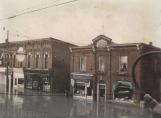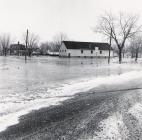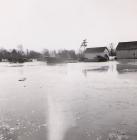14
Men on Raft
April, 1937
Thamesville, Ontario, Canada

15
While Sandy searched for high ground, Lloyd was sent uptown to retrieve some necessary provisions for his family. On his way back home he was walking through water that was waist high. By noon that day the water was on Mrs. McFarlane’s floor so Lloyd and his family decided to return to their own home. They went by boat and floated right through the front door and into the front hall where they stepped on the stairway. Lloyd describes how the water reached its peak that night, Wednesday April 28, 1937. "Our house had 26 inches of water on the rear floors and 22 inches on the front floors of the house. Water came to within a few inches of the keyboards of two pianos." Lloyd and his family had the only option of remaining in their home to sit and wait for the waters to recede. He remembers much of their time was spent listening to the radio broadcasts so they were updated on the happenings of the flood.
16
Red Parney
April, 1937
Thamesville, Ontario, Canada

17
By morning on April 29th, the water was going down by an inch an hour and by Friday morning the waters had finally left the streets of Thamesville. That morning, Lloyd went to work to help the Red Cross deliver clean water and deliver the Windsor Daily Star newspapers for the past three days. Lloyd also worked in the United Church Sunday school room shoveling the mud and silt out of the building. "There was a coating of about half an inch of silt on everything including floors, sidewalks, roads and even the lawns."
The following week school was cancelled and many of Lloyd’s customers cancelled their papers in protest. It seems the citizens were upset about the humorous coverage of the flood that appeared in the Windsor paper. "I agreed with their course of action and passed along their objections."
After the floodwaters receded the trouble was not over. Health issues became a high concern and clean up would still take days before the town would be returned to normal.
18
Flooded Land
May, 1937
Thamesville, Ontario, Canada

19
Neil Hubbell tells his story of the 1937 flood from a rural standpoint. While the people in town were troubled about getting things out of their basements and raising their furniture up higher, people in the rural areas and those living on farms had concerns about their livestock. Neil’s story about how they managed to rescue their farm animals is very similar to any person living in a rural area during the flood of 1937.
Later that day when Neil went to check on their cows in the field, he discovered that they were surrounded by water. Neil and his father knew they could not get them back to the barn due to all the water that was now rising between the field and the barn. They chose to drive the cattle along the railway to the stockyards. One stubborn cow strayed away from where they were leading the cattle and she went into a ditch that was full of water, "I thought well if we lose just one cow, we will be lucky." Luckily, the old cow was able to get a hold of the solid bank and pull herself up onto the tracks with the rest of the cattle. Neil and his father were able to successfully lead all their cattle to the stockyards.
20
Corner of Jane and Victoria
April, 1937
Thamesville, Ontario, Canada

21
On the second day of the flood the water was much higher as it had been rising all through the night. "It became quite deep and kept rising about an inch an hour." Neil explained that his family used their front steps to measure the depth of the floodwaters.. Later that day when Neil went to check on their cows in the field, he discovered that they were surrounded by water. Neil and his father knew they could not get them back to the barn due to all the water that was now rising between the field and the barn. They chose to drive the cattle along the railway to the stockyards. One stubborn cow strayed away from where they were leading the cattle and she went into a ditch that was full of water, "I thought well if we lose just one cow, we will be lucky." Luckily, the old cow was able to get a hold of the solid bank and pull herself up onto the tracks with the rest of the cattle. Neil and his father were able to successfully lead all the cattle to the stockyards and put them in the pens with the other stock. On the second day of the flood the water was much higher as it had been rising all through the night. "It became quite deep and kept rising about an inch an hour." Neil explained that his family used their front steps to measure the depth of the floodwaters.
22
Barns
May 7, 1937
Thamesville, Ontario, Canada

23
Later that day when Neil looked out the window he saw two sows swimming past his house in the current. When he went outside to call them, to his surprise they turned around and headed towards the barn. He was able to get the sows into the barn and out of the water. While Neil was in the barn with the sows, he decided he would check on the horses in the manger. Once he got there and checked the floor, Neil realized that water was beginning to seep through the cracks in the floorboards. "The floor was of two inch planks and not nailed down, I knew if they started to float, the horses would be in trouble but what could I do?" Neil knew that he could not let the horses go loose into the water because they would have no idea what to do or where to go. They would lose their horses if he did this so Neil decided that they needed to somehow get the horses to the stockyards with the rest of the livestock. It just so happens that Les Nutt and Pat Kelley were nearby at Edgar Sherman’s place loading his pigs into a gravel truck. Once they had finished loading the pigs, they jumped into another truck to head into town. When they were in front of the Hubbell home the engine got too wet and it stopped. Neil took this opportunity and asked Les and Pat if they would help him take the horses into town. "If they would ride one horse and lead another that would take care of 4 horses and I would ride the 5th one." Neil did not know that the ramp to the stable door had floated away so when the horses stepped outside they fell out about 3 feet to the ground. This was a good thing as it prevented the horses from panicking and stepping back into the stable. The men were able to get the horses to the stockyards safely but once they arrived they discovered the barns were full. "We had to hunt places for 4 of the horses. Then I took the 5th horse over to the freight shed to try and find a place to tie it."
24
Watson and Ruckle Drugstore
April, 1937
Thamesville, Ontario, Canada

25
Neil’s stepmother’s sister, Jean Kelly lived with them at the time and she was an operator at the Telephone Office. By the third day of the flood the water had gone down a bit but Jean was eager to get into town. She wanted to relieve the girls who had been stranded at the office since the start of flood. They had been working 24 hours a day. Mr. Sherman came over with his flat bottom boat that was used for transporting gravel and was able to paddle Jean into town. From what we can tell by Neil’s tale of the 1937 flood the Hubbell family did not lose any of their livestock. Neil’s account of the flood is important because we can understand just how much work it was for the farmers in the rural areas to save their livestock and get them to safety once the floodwaters began to take over the area.
26
Barns
April, 1937
Thamesville, Ontario, Canada

27
Jean (Bowden) Atkinson was only sixteen years old during the time of the 1937 flood. Her family heard the warnings from London and in no time it seemed that they could hear the water lapping against the floorboards of their house. Jean explained that once the water broke through the railway, it covered the fields and soon their house was surrounded by the floodwaters. "Daddy managed to secure the heavy hay rope to the big walnut tree by our house and then to the barn. By hanging on to this rope he was able to get to the barn in a sap pan (4’x6’) without being swept downstream. This was his mode of transportation."






